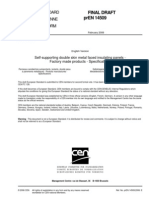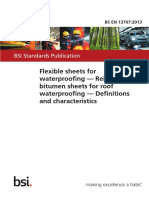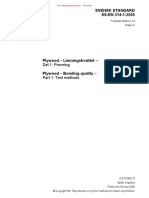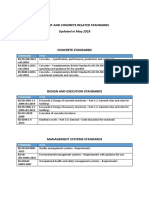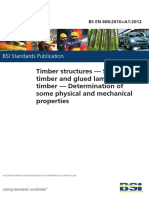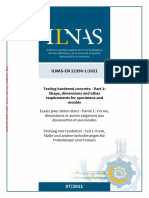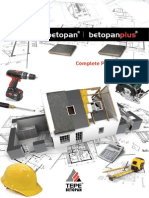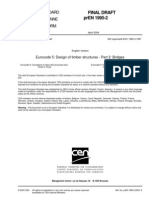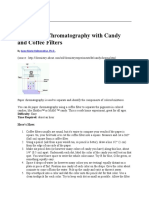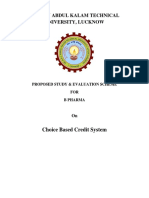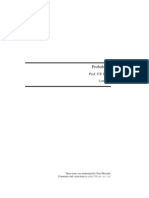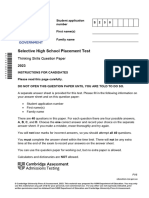Professional Documents
Culture Documents
EN300 Eng 2006
Uploaded by
Pedro MendesOriginal Description:
Original Title
Copyright
Available Formats
Share this document
Did you find this document useful?
Is this content inappropriate?
Report this DocumentCopyright:
Available Formats
EN300 Eng 2006
Uploaded by
Pedro MendesCopyright:
Available Formats
BRITISH STANDARD
BS EN 300:2006
Oriented Strand Boards (OSB) Definitions, classification and specifications
The European Standard EN 300:2006 has the status of a British Standard
ICS 79.060.20
12 &23<,1* :,7+287 %6, 3(50,66,21 (;&(37 $6 3(50,77(' %< &23<5,*+7 /$:
BS EN 300:2006
National foreword
This British Standard was published by BSI. It is the UK implementation of EN 300:2006. It supersedes BS EN 300:1997 which is withdrawn. The UK participation in its preparation was entrusted to Technical Committee B/541, Wood based panels. A list of organizations represented on B/541 can be obtained on request to its secretary. This publication does not purport to include all the necessary provisions of a contract. Users are responsible for its correct application. Compliance with a British Standard cannot confer immunity from legal obligations.
This British Standard was published under the authority of the Standards Policy and Strategy Committee on 31 August 2006
Amendments issued since publication Amd. No. Date Comments
BSI 2006
ISBN 0 580 49105 6
EUROPEAN STANDARD NORME EUROPENNE EUROPISCHE NORM
ICS 79.060.20
EN 300
July 2006
Supersedes EN 300:1997
English Version
Oriented Strand Boards (OSB) - Definitions, classification and specifications
Panneaux de lamelles minces, longues et orientes (OSB) - Dfinitions, classification et exigences Platten aus langen, flachen, ausgerichteten Spnen (OSB) - Definitionen, Klassifizierung und Anforderungen
This European Standard was approved by CEN on 24 May 2006. CEN members are bound to comply with the CEN/CENELEC Internal Regulations which stipulate the conditions for giving this European Standard the status of a national standard without any alteration. Up-to-date lists and bibliographical references concerning such national standards may be obtained on application to the Central Secretariat or to any CEN member. This European Standard exists in three official versions (English, French, German). A version in any other language made by translation under the responsibility of a CEN member into its own language and notified to the Central Secretariat has the same status as the official versions. CEN members are the national standards bodies of Austria, Belgium, Cyprus, Czech Republic, Denmark, Estonia, Finland, France, Germany, Greece, Hungary, Iceland, Ireland, Italy, Latvia, Lithuania, Luxembourg, Malta, Netherlands, Norway, Poland, Portugal, Romania, Slovakia, Slovenia, Spain, Sweden, Switzerland and United Kingdom.
EUROPEAN COMMITTEE FOR STANDARDIZATION COMIT EUROPEN DE NORMALISATION EUROPISCHES KOMITEE FR NORMUNG
Management Centre: rue de Stassart, 36
B-1050 Brussels
2006 CEN
All rights of exploitation in any form and by any means reserved worldwide for CEN national Members.
Ref. No. EN 300:2006: E
EN 300:2006
Contents
1 2 3 4 5 6 7 8 9 9.1 9.2 9.3 10 10.1 10.2 10.3 11 11.1 11.2 11.3 12 12.1 12.2
Page
Foreword..............................................................................................................................................................4 Scope ......................................................................................................................................................5 Normative references ............................................................................................................................5 Terms and definitions ...........................................................................................................................6 Classification of boards ........................................................................................................................7 General requirements for all OSB types .............................................................................................7 Requirement values...............................................................................................................................9 Requirements for non load-bearing boards, general purpose boards and boards for interior fitments for use in dry conditions (Type OSB/1) ..................................................................9 Requirements for load-bearing boards for use in dry conditions (Type OSB/2) ..........................10 Requirements for load-bearing boards for use in humid conditions (Type OSB/3) .....................11 General..................................................................................................................................................11 Mechanical and swelling properties ..................................................................................................11 Moisture resistance .............................................................................................................................11 Requirements for heavy duty load-bearing boards for use in humid conditions (Type OSB/4) ...................................................................................................................................................12 General..................................................................................................................................................12 Mechanical and swelling properties ..................................................................................................13 Moisture resistance .............................................................................................................................13 Verification of compliance ..................................................................................................................14 General..................................................................................................................................................14 External control, and inspection of an isolated lot ..........................................................................14 Factory production control.................................................................................................................15 Marking .................................................................................................................................................15 Boards marketed within the European Economic Area for construction applications................15 Other boards ........................................................................................................................................16
Annex A (normative) EN 1087-1 (Modified procedure) ................................................................................17 Annex B (normative) Voluntary colour coding system for OSB .................................................................18 Annex C (normative) Supplementary properties..........................................................................................19 Bibliography ......................................................................................................................................................20 Tables Table 1 General requirements for all OSB types ........................................................................................8 Table 2 Non load-bearing boards, general purpose boards and boards for interior fitments for use in dry conditions Requirements for specified mechanical and swelling properties ...........9 Table 3 Load-bearing boards for use in dry conditions Requirements for specified mechanical and swelling properties ..................................................................................................10 Table 4 Load-bearing boards for use in humid conditions Requirements for specified mechanical and swelling properties ..................................................................................................11 Table 5 Load-bearing boards for use in humid conditions Requirements for moisture resistance .............................................................................................................................................12
EN 300:2006
Table 6 Heavy duty load-bearing boards for use in humid conditions Requirements for specified mechanical and swelling properties .................................................................................13 Table 7 Heavy duty load-bearing boards for use in humid conditions Requirements for moisture resistance.............................................................................................................................14 Table 8 Maximum intervals between tests for each production line ......................................................15 Table B.1 Voluntary colour coding for OSB .............................................................................................17 Table C.1 - Supplementary properties and test methods.............................................................................18
EN 300:2006
Foreword
This document (EN 300:2006) has been prepared by Technical Committee CEN/TC 112 Wood-based panels, the secretariat of which is held by DIN. This European Standard shall be given the status of a national standard, either by publication of an identical text or by endorsement, at the latest by January 2007, and conflicting national standards shall be withdrawn at the latest by January 2007. This document supersedes EN 300:1997. The following principal modifications have been made: a) b) c) d) thickness ranges for board types OSB/2, OSB/3 and OSB/4 have been extended; requirements for moisture resistance have been adapted; requirements for the marking of boards have been simplified, taking account of the fact that EN 13986 now describes the detailed requirements for CE marking of boards for use in construction; former Annexes E (list of approval numbers for option 2 board types with certain adhesives or adhesive systems) and F (A-deviations) have been deleted.
According to the CEN/CENELEC Internal Regulations, the national standards organizations of the following countries are bound to implement this European Standard: Austria, Belgium, Cyprus, Czech Republic, Denmark, Estonia, Finland, France, Germany, Greece, Hungary, Iceland, Ireland, Italy, Latvia, Lithuania, Luxembourg, Malta, Netherlands, Norway, Poland, Portugal, Romania, Slovakia, Slovenia, Spain, Sweden, Switzerland and United Kingdom.
EN 300:2006
Scope
This European Standard applies to Oriented Strand Boards (OSB). It defines terms, establishes a classification and specifies requirements. The values listed in this European Standard relate to product properties but they are not characteristic values to be used in design calculations.
NOTE Test methods for determination of mechanical properties for structural purposes are given in EN 789. Determination of characteristic values of mechanical properties and density for structural purposes is given in EN 1058. Design characteristic values for OSB are given in EN 12369-1.
Information on supplementary properties is given in Annex C.
Normative references
The following referenced documents are indispensable for the application of this document. For dated references, only the edition cited applies. For undated references, the latest edition of the referenced document (including any amendments) applies. EN 120, Wood-based panels - Determination of formaldehyde content - Extraction method called the perforator method EN 310, Wood-based panels - Determination of modulus of elasticity in bending and of bending strength EN 317, Particleboards and fibreboards - Determination of swelling in thickness after immersion in water EN 318, Wood-based panels - Determination of dimensional changes associated with changes in relative humidity EN 319, Particleboards and fibreboards - Determination of tensile strength perpendicular to the plane of the board EN 320, Fibreboards - Determination of resistance to axial withdrawal of screws EN 321, Wood based panels - Determination of moisture resistance under cyclic test conditions EN 322, Wood-based panels - Determination of moisture content EN 323, Wood-based panels - Determination of density EN 324-1, Wood-based panels - Determination of dimensions of boards - Part 1: Determination of thickness, width and length EN 324-2, Wood-based panels - Determination of dimension of boards - Part 2: Determination of squareness and edge straightness EN 326-1, Wood-based panels - Sampling, cutting and inspection - Part 1: Sampling and cutting of test pieces and expression of test results EN 326-2, Wood-based panels - Sampling, cutting and inspectionPart 2: Quality control in the factory EN 326-3, Wood-based panels - Sampling, cutting and inspection - Part 3: Inspection of an isolated lot of panels EN 594, Timber structures - Test methods - Racking strength and stiffness of timber frame wall panels
EN 300:2006
EN 596, Timber structures - Test methods - Soft body impact test of timber framed walls EN 717-1, Wood-based panels - Determination of formaldehyde release - Part 1: Formaldehyde emission by the chamber method EN 789, Timber structures - Test methods - Determination of mechanical properties of wood-based panels EN 1058, Wood-based panels - Determination of characteristic values of mechanical properties and density EN 1087-1, Particleboards - Determination of moisture resistance - Part 1: Boil test ENV 1156, Wood-based panels - Determination of duration of load and creep factors EN 1195, Timber structures - Test methods - Performance of structural floor decking EN 12369-1, Wood-based panels - Characteristic values for structural design - Part 1: OSB, particleboards and fibreboards EN 12871, Wood-based panels - Performance specifications and requirements for load bearing boards for use in floors, walls and roofs EN 13986:2004, Wood-based panels for use in construction - Characteristics, evaluation of conformity and marking
Terms and definitions
For the purposes of this document, the terms and definitions given in EN 13986:2004 and the following apply. 3.1 Oriented Strand Board (OSB) multi-layered board mainly made from strands of wood together with a binder. The strands in the external layer are aligned and parallel to the board length or width. The strands in the internal layer or layers can be randomly orientated or aligned, generally at right angles to the strands in the external layers 3.2 strand piece of wood of a predetermined shape with a length of more than 50 mm and a typical thickness of less than 2 mm 3.3 major axis direction in the plane of the board in which the bending properties have the higher values 3.4 minor axis direction in the plane of the board at right angles to the major axis 3.5 dry conditions conditions corresponding to service class 1 of EN 1995-1-1 which is characterised by a moisture content in the material corresponding to a temperature of 20 C and a relative humidity of the surrounding air only exceeding 65 % for a few weeks per year
EN 300:2006
3.6 humid conditions conditions corresponding to service class 2 of EN 1995-1-1 which is characterised by a moisture content in the material corresponding to a temperature of 20 C and a relative humidity of the surrounding air only exceeding 85 % for a few weeks per year
Classification of boards
Four types of board are classified and are distinguished as follows: OSB/1 general purpose non load-bearing boards, and boards for interior fitments for use in dry conditions; OSB/2 load-bearing boards for use in dry conditions; OSB/3 load-bearing boards for use in humid conditions; OSB/4 heavy duty load-bearing boards for use in humid conditions.
NOTE Load-bearing boards are intended for use in the design and construction of load-bearing or stiffening building elements e.g. walls, flooring, roofing and I-beams (see EN 1995-1-1 and/or performance standards) for use in dry or humid conditions
General requirements for all OSB types
Oriented Strand Boards shall comply with the general requirements listed in Table 1 when dispatched from the producing factory.
NOTE On delivery of OSB panels, their moisture content should be determined prior to use, and allowed to come into equilibrium with the ambient climatic conditions.
EN 300:2006
Table 1 General requirements for all OSB types No. 1 ab Property Tolerances on nominal dimensions: 2
ab
Test method EN 324-1
Requirement
thickness (sanded within and between boards; thickness (un-sanded) within and between boards; length and width EN 324-2 EN 324-2 EN 322 EN 323
0,3 mm 0,8 mm 3,0 mm 1,5 mm/m 2,0 mm/m 2 % to 12 % 15 %
Edge straightness tolerance Squareness tolerance Moisture content Tolerance on the mean density within a board Formaldehyde release according to EN 13986 Class E 1 Perforator value
f
3 ab 4a 5b 6
e
EN 120
Content 8 mg/100 g d oven dry board Release 0,124 mg/m air
3
Steady state emission value c Class E 2 Perforator value
f
EN 717-1
EN 120
Content > 8 mg/100 g d oven dry board 30 mg/100 g oven dry board Release > 0,124 mg/m air
3
Steady state emission value
a b
EN 717-1
Certain users of OSB can require other tolerances (see separate performance standards, e.g. EN 12871). These values are characterised by a moisture content in the material corresponding to a relative humidity of 65 % and a temperature of 20 C. Experience has shown that to ensure compliance with the limit for class E1 the rolling average of the EN 120 values found from the factory production control over a period of six months should not exceed 6,5 mg formaldehyde 100 g panel mass for OSB. Initial type testing may be carried out for formaldehyde class E1 (established products only) on the basis of existing data with either EN 120 or pr EN 717-1 testing, either from factory production control or from external inspection, see EN 13986. For more detail concerning the formaldehyde classes and requirements, see EN 13986. The perforator values apply to boards with moisture content H of 6,5 %. In the case of boards with different moisture content (in the range of 3 % H 10 %) the perforator value shall be multiplied by a factor F which can be calculated from the following equation: F= 0,133 H + 1,86.
e f
EN 300:2006
Requirement values
The values which are given in Tables 2 to 7, determined by the relevant test methods as listed in Clauses 7 to 10, are to be used for factory production control (FPC) purposes only and shall not be used in design calculations. With the exception of the moisture resistance requirements in Tables 5 and 7 and the swelling in thickness requirements given in Tables 2 to 4 and 6, the values given in Tables 2 to 7 are characterised by a moisture content in the material corresponding to a relative humidity of 65 % and a temperature of 20 C. The values for the moisture resistance requirements in Tables 5 and 7 and swelling in thickness (Tables 2 to 4 and 6) are characterised by a moisture content in the material before the treatment corresponding to a relative humidity of 65 % and a temperature of 20 C. The requirements in Tables 2 to 7 shall be met by 5 percentile values (95 percentile values in the case of swelling in thickness) based on the mean values for individual boards and calculated in accordance with EN 326-1, or (for continuous internal FPC) EN 326-2. In the case of swelling in thickness they shall be equal to or less than the values in the Tables 2 to 4 and 6 and in the case of all other properties they shall be equal to or greater than the values in the tables.
Requirements for non load-bearing boards, general purpose boards and boards for interior fitments for use in dry conditions (Type OSB/1)
This clause specifies the requirements in addition to those specified in Clause 5, for non load-bearing boards, general purpose boards and boards for interior fitments for use in dry conditions. Therefore, boards of this type shall comply with the requirements given in Table 1 and Table 2.
NOTE Boards of this type are only suitable for use in biological hazard class 1 of EN 335-3.
For definitions of values given in the tables see Clause 6. Table 2 Non load-bearing boards, general purpose boards and boards for interior fitments for use in dry conditions Requirements for specified mechanical and swelling properties Board type (technical class) OSB/1 Property Bending strength major axis Bending strength minor axis Modulus of elasticity in bending major axis Modulus of elasticity in bending minor axis Internal bond Swelling in thickness 24 h immersion EN 310 EN 310 EN 310 EN 310 EN 319 EN 317 N/mm N/mm N/mm N/mm N/mm %
2 2 2 2 2
Test method
Requirement Unit Board thickness range (mm, nominal) 6 to 10 20 10 2 500 1 200 0,30 25 > 10 to < 18 18 9 2 500 1 200 0,28 25 18 to 25 16 8 2 500 1 200 0,26 25
EN 300:2006
Requirements for load-bearing boards for use in dry conditions (Type OSB/2)
This clause specifies the requirements, in addition to those specified in Clause 5, for load-bearing boards for use in dry conditions. Therefore, boards of this type shall comply with the requirements given in Table 1 and Table 3.
NOTE Boards of this type are only suitable for use in biological hazard class 1 of EN 335-3.
For determining characteristic values, see Clause 1. Design characteristics for OSB are given in EN 12369-1 only for thickness classes up to 25 mm. For the higher thicknesses, tests have to be performed according to EN 789 and EN 1058. For definitions of values given in the tables, see Clause 6. Table 3 Load-bearing boards for use in dry conditions Requirements for specified mechanical and swelling properties Board type (technical class) OSB/2 Property Bending strength major axis Bending strength minor axis Modulus of elasticity in bending major axis Modulus of elasticity in bending minor axis Internal bond Swelling in thickness 24 h immersion EN 310 EN 310 EN 310 EN 310 EN 319 EN 317 N/mm N/mm N/mm N/mm N/mm %
2
Test method
Unit
Requirement Board thickness range (mm, nominal) 6 to 10 > 10 to < 18 22 11 3 500 1 400 0,34 20 20 10 3 500 1 400 0,32 20 18 to 25 18 9 3 500 1 400 0,30 20 > 25 to 32 > 32 to 40 16 8 3 500 1 400 0,29 20 14 7 3 500 1 400 0,26 20
If it is made known by the purchaser that the boards are intended for specific use in flooring, walls or roofing, the performance standard EN 12871 has also to be consulted. This can result in additional requirements having to be complied with.
10
EN 300:2006
9
9.1
Requirements for load-bearing boards for use in humid conditions (Type OSB/3)
General
This clause specifies the requirements, in addition to those specified in Clause 5, for load-bearing boards for use in humid conditions. Therefore, boards of this type shall comply with the requirements of Tables 1, 4 and 5.
NOTE Boards of this type are suitable for use in biological hazard classes 1 and 2 of EN 335-3.
For determining characteristic values, see Clause 1. Design characteristics for OSB are given in EN 12369-1 only for thickness classes up to 25 mm. For the higher thicknesses, tests have to be performed according to EN 789 and EN 1058. For definitions of values given in the tables, see Clause 6.
9.2
Mechanical and swelling properties
Table 4 Load-bearing boards for use in humid conditions Requirements for specified mechanical and swelling properties Board type (technical class) OSB/3 Property Bending strength major axis Bending strength minor axis Modulus of elasticity in bending major axis Modulus of elasticity in bending minor axis Internal bond Swelling in thickness 24 h immersion EN 310 EN 310 EN 310 EN 310 EN 319 EN 317 N/mm N/mm N/mm N/mm N/mm %
2
Test method
Unit
Requirement Board thickness range (mm, nominal) 6 to 10 > 10 to < 18 22 11 3 500 1 400 0,34 15 20 10 3 500 1 400 0,32 15 18 to 25 18 9 3 500 1 400 0,30 15 > 25 to 32 > 32 to 40 16 8 3 500 1 400 0,29 15 14 7 3 500 1 400 0,26 15
If it is made known by the purchaser that the boards are intended for specific use in flooring, walls or roofing, the performance standard EN 12871 has also to be consulted. This can result in additional requirements having to be complied with.
9.3
Moisture resistance
For the requirements for moisture resistance, two options are set out in Table 5 corresponding to the two principal recognised methods of evaluation. It is necessary for the manufacturer to show compliance with only one of these two options. Option 1 requirements apply to boards subjected to an accelerated ageing test, the so-called cyclic test, described in EN 321. Option 2 requirements apply to boards subjected to the so-called boil test described in EN 1087-1. The glues or adhesive systems suitable for the application of either option 1 or option 2 are unrestricted.
11
EN 300:2006
For Option 1, there are two alternative sets of requirements, either through measuring internal bond after cyclic test (alternative A) or through measuring bending strength after cyclic test (alternative B). It is necessary for the manufacturer to show compliance with only one of these two alternatives. When verifying compliance by external control only the test option performed and notified by the manufacturer shall be carried out. If the option is unknown it will be necessary to carry out both sets of the procedures, but compliance is required with only one set of requirements. Table 5 Load-bearing boards for use in humid conditions Requirements for moisture resistance Board type (technical class) OSB/3 Property Option 1 alternative A Internal bond after cyclic test Option 1 alternative B Bending strength after cyclic test major axis Option 2 Internal bond after boil test
a
Test method
Unit
Requirement Board thickness range (mm, nominal) 6 to 10 > 10 to < 18 0,15 18 to 25 0,13 > 25 to 32 0,10 > 32 to 40 0,08
EN 321 + EN 319
N/mm
0,18
EN 321 + EN 310 a
N/mm
EN 1087-1 b
N/mm
0,15
0,13
0,12
0,06
0,05
For the calculation of bending strength after cyclic test, the thickness taken into account is the thickness measured after the cyclic test. EN 1087-1 shall be used with the modified procedure given in Annex A.
10 Requirements for heavy duty load-bearing boards for use in humid conditions (Type OSB/4)
10.1 General
This clause specifies the requirements in addition to those specified in Clause 5, for heavy duty load-bearing boards for use in humid conditions. Therefore, boards of this type shall comply with the requirements of Tables 1, 6 and 7.
NOTE Boards of this type are suitable for use in biological hazard classes 1 and 2 of EN 335-3.
For determining characteristic values, see Clause 1. Design characteristics for OSB are given in EN 12369-1 only for thickness classes up to 25 mm. For the higher thicknesses, tests have to be performed according to EN 789 and EN 1058. For definitions of values given in tables see Clause 6.
12
EN 300:2006
10.2 Mechanical and swelling properties
Table 6 Heavy duty load-bearing boards for use in humid conditions Requirements for specified mechanical and swelling properties Board type (technical class) OSB/4 Property Bending strength major axis Bending strength minor axis Modulus of elasticity in bending major axis Modulus of elasticity in bending minor axis Internal bond Swelling in thickness 24 h immersion EN 310 EN 310 EN 310 EN 310 EN 319 EN 317 N/mm N/mm N/mm N/mm N/mm %
2
Test method
Unit
Requirement Board thickness range (mm, nominal) 6 to 10 > 10 to < 18 30 16 4 800 1 900 0,50 12 28 15 4 800 1 900 0,45 12 18 to 25 26 14 4 800 1 900 0,40 12 > 25 to 32 > 32 to 40 24 13 4 800 1 900 0,35 12 22 12 4 800 1 900 0,30 12
If it is made known by the purchaser that the boards are intended for specific use in flooring, walls or roofing, the performance standard EN 12871 has also to be consulted. This can result in additional requirements having to be complied with.
10.3 Moisture resistance
See 9.3 and apply Table 7.
13
EN 300:2006
Table 7 Heavy duty load-bearing boards for use in humid conditions Requirements for moisture resistance Board type (technical class) OSB/4 Property Option 1 alternative A Internal bond after cyclic test Option 1 alternative B Bending strength after cyclic test major axis Option 2 Internal bond after boil test
a
Test method
Unit
Requirement Board thickness range (mm, nominal) 6 to 10 > 10 to < 18 0,17 18 to 25 0,15 > 25 to 32 0,10 > 32 to 40 0,08
EN 321 + EN 319
N/mm
0,21
EN 321 + EN 310 a
N/mm
15
14
13
EN 1087-1 b
N/mm
0,17
0,15
0,13
0,06
0,05
For the calculation of bending strength after cyclic test, the thickness taken into account is the thickness measured after the cyclic test. EN 1087-1 shall be used with the modified procedure given in Annex A.
11 Verification of compliance
11.1 General
Verification of compliance with this EN shall be carried out using the test methods given in the relevant tables above. Sampling and cutting of test pieces and expression of test results shall be in accordance with EN 326-1. For boards for use in construction applications EN 13986 applies.
11.2 External control, and inspection of an isolated lot
External control of the factory, if any, shall be carried out according to EN 326-2.
NOTE The inspection of an isolated lot of panels may be carried out according to EN 326-3. EN 326-3 is a nonmandated standard. Therefore, its use is voluntary in the absence of agreement between buyer and seller on an alternative procedure for checking an isolated lot of panels.
In the case of formaldehyde potential, however, for both external control according to EN 120, and inspection of an isolated lot of panels if the method according to EN 326-3 is used, the respective requirement set out in Table 1 shall be met by the mean value of at least three boards. Additionally, no individual board shall exceed an upper tolerance limit of + 10 %.
14
EN 300:2006
11.3 Factory production control
Factory production control shall be carried out according to EN 326-2. The properties listed in the tables shall be controlled using intervals between tests not exceeding the intervals given in Table 8. Sampling shall be carried out at random. The intervals between tests given in Table 8 are related to a production under statistical control. Each requirement relating to formaldehyde potential (perforator value) shall be met by the 95 percentile value based on test values of individual boards. The 95 percentile value shall be equal to or less than the respective tabulated value given in Table 1. Alternative test methods and/or unconditioned test pieces may be used if a valid correlation to the specified test methods can be proven (see EN 326-2). For specifications, claims etc., only the methods specified in this European Standard shall be used. Table 8 Maximum intervals between tests for each production line Property Moisture content Formaldehyde potential (Table 1) a All other properties listed in Table 1 Moisture resistance (Table 5 and Table 7) All other properties listed in Tables 2 to 7
a
Maximum interval between tests b 8 h per type of board Class E1 Class E2 Option 1 Option 2 24 h per type of board One week per type of board 8 h per type and thickness range One week per type of board 8 h per type of board c 8hc
Certain types of OSB are known to release little or no formaldehyde. In these cases, the test intervals may be increased. However, it remains the responsibility of the manufacturer and inspection agency, if any, to ensure compliance with this European Standard. If a given property does not meet the requirements, frequency shall be increased in accordance with internal procedures in the factory or with external procedures applied by an inspection agency (if any). If several thickness ranges are produced in one 8h shift, the internal control shall be organised so that at least one board of each thickness range is tested in one weeks production.
12 Marking
12.1 Boards marketed within the European Economic Area for construction applications
Boards produced in conformity with this European Standard and marketed in any of the territories of the European Economic Area for use in construction applications as defined in the Construction Products Directive (89/106/EEC) shall be marked according to the requirements of EN 13986.
NOTE In certain countries only products of formaldehyde class E1 are allowed.
15
EN 300:2006
12.2 Other boards
In the case of other boards produced in conformity with this European Standard, each panel or package shall be clearly marked by the manufacturer by indelible direct printing with at least the following information in this sequence: a) manufacturer's name, trade mark, or identification mark; b) number of this European Standard, i.e. EN 300; c) panel type e.g. OSB/2; d) nominal thickness; e) major axis (if no the length of the panel); f) formaldehyde class;
g) batch number, or production week and year. In addition, colour coding may be voluntarily applied to panels. If applied with the use of colour combinations, it shall be according to the system shown in Annex B; but this European Standard does not exclude the dyeing of the whole panel or of certain layers of the panel according to traditional national practices.
16
EN 300:2006
Annex A (normative) EN 1087-1 (Modified procedure)
EN 1087-1:1995 shall be used with the following modifications in the clauses. Add the following subclause: 4.5 Air circulating oven capable of maintaining an internal temperature of (70 2) C
Add the following sentence in 5.5 5.5 The bonding of the test pieces to the testing blocks shall only be carried out after the boil and subsequent treatments have been completed. All other aspects of this subclause apply. 6 Procedure replace with the following subclause:
6.2 After (120 5) min remove the test pieces and immerse them in water at (20 5) C for (60 5) min. The test pieces shall have their faces vertical and be separated from each other and from the sides and the bottom of the water bath by at least 15 mm. Remove the test pieces from the water, dry them with a paper towel and place them, with their faces horizontal, in the oven at (70 2) C for (960 15) min. Remove the test pieces from the oven, allow them to cool to approximately room temperature and bond the loading blocks to the faces.
NOTE If the surface of the test pieces is rough or uneven, they can be smoothed before bonding on the blocks by rubbing on a piece of abrasive paper which is held on a flat surface.
17
EN 300:2006
Annex B (normative) Voluntary colour coding system for OSB
Two colours are used in each case. The first colour defines the panel as either intended for general purpose use or for load bearing applications (either one or two stripes of this colour are used). The second colour identifies the panel as being suitable for use in either dry or humid conditions. The colours used are as follows: First colour Second colour White Yellow Blue Green General purpose Load-bearing Dry conditions Humid conditions Table B.1 Voluntary colour coding for OSB OSB Type OSB/1 OSB/2 OSB/3 OSB/4 Colour code White, blue Yellow, yellow, blue Yellow, yellow, green Yellow, green
18
EN 300:2006
Annex C (normative) Supplementary properties
For certain applications, information on some supplementary properties may be required. On request, this information shall be supplied by the manufacturer. Supplementary properties together with the appropriate EN test methods are listed in Table C.1. Table C1 Supplementary properties and test methods Physical properties Dimensional changes Mechanical properties Screw withdrawal Duration of load/creep Tension a Compression Shear a Bending a Impact resistance Performance properties Flooring Walls Roofing
a a
Test method EN 318 EN 320 ENV 1156 EN 789 EN 789 EN 789 EN 789 EN 1195 EN 1195, EN 12871 EN 594, EN 596, EN 12871 EN 1195, EN 12871
Characteristic values for these properties are given in EN 12369-1.
19
EN 300:2006
Bibliography
[1] [2] [3] [4]
EN 312 (all parts), Particleboards - Specifications EN 335-3, Durability of wood and wood-based products - Definition of hazard classes of biological attack Part 3: Application to wood-based panels EN 1995-1-1, Eurocode 5:Design of timber structures - Part 1-1: General - Common rules and rules for buildings EN 13501-1, Fire classification of construction products and building elements - Part 1: Classification using test data from reaction to fire tests
20
blank
BS EN 300:2006
BSI British Standards Institution
BSI is the independent national body responsible for preparing British Standards. It presents the UK view on standards in Europe and at the international level. It is incorporated by Royal Charter. Revisions British Standards are updated by amendment or revision. Users of British Standards should make sure that they possess the latest amendments or editions. It is the constant aim of BSI to improve the quality of our products and services. We would be grateful if anyone finding an inaccuracy or ambiguity while using this British Standard would inform the Secretary of the technical committee responsible, the identity of which can be found on the inside front cover. Tel: +44 (0)20 8996 9000. Fax: +44 (0)20 8996 7400. BSI offers members an individual updating service called PLUS which ensures that subscribers automatically receive the latest editions of standards. Buying standards Orders for all BSI, international and foreign standards publications should be addressed to Customer Services. Tel: +44 (0)20 8996 9001. Fax: +44 (0)20 8996 7001. Email: orders@bsi-global.com. Standards are also available from the BSI website at http://www.bsi-global.com. In response to orders for international standards, it is BSI policy to supply the BSI implementation of those that have been published as British Standards, unless otherwise requested. Information on standards BSI provides a wide range of information on national, European and international standards through its Library and its Technical Help to Exporters Service. Various BSI electronic information services are also available which give details on all its products and services. Contact the Information Centre. Tel: +44 (0)20 8996 7111. Fax: +44 (0)20 8996 7048. Email: info@bsi-global.com. Subscribing members of BSI are kept up to date with standards developments and receive substantial discounts on the purchase price of standards. For details of these and other benefits contact Membership Administration. Tel: +44 (0)20 8996 7002. Fax: +44 (0)20 8996 7001. Email: membership@bsi-global.com. Information regarding online access to British Standards via British Standards Online can be found at http://www.bsi-global.com/bsonline. Further information about BSI is available on the BSI website at http://www.bsi-global.com. Copyright Copyright subsists in all BSI publications. BSI also holds the copyright, in the UK, of the publications of the international standardization bodies. Except as permitted under the Copyright, Designs and Patents Act 1988 no extract may be reproduced, stored in a retrieval system or transmitted in any form or by any means electronic, photocopying, recording or otherwise without prior written permission from BSI. This does not preclude the free use, in the course of implementing the standard, of necessary details such as symbols, and size, type or grade designations. If these details are to be used for any other purpose than implementation then the prior written permission of BSI must be obtained. Details and advice can be obtained from the Copyright & Licensing Manager. Tel: +44 (0)20 8996 7070. Fax: +44 (0)20 8996 7553. Email: copyright@bsi-global.com.
BSI 389 Chiswick High Road London W4 4AL
You might also like
- Eurocode 9 Design of Aluminium Structures PDFDocument230 pagesEurocode 9 Design of Aluminium Structures PDFmarineugenNo ratings yet
- GeographyDocument18 pagesGeographyAshley Morgan88% (8)
- 13381.04 ENV-en 2003 PDFDocument78 pages13381.04 ENV-en 2003 PDFΚώστας Πετρακογιώργης100% (1)
- BS5507-3 1982Document11 pagesBS5507-3 1982surangaNo ratings yet
- BS en 14695 2010 Flexible Sheets For WaterproofingDocument30 pagesBS en 14695 2010 Flexible Sheets For WaterproofingNomatter MariusNo ratings yet
- 2020 - (Sankaran) - Data Analytics in Reservoir EngineeringDocument107 pages2020 - (Sankaran) - Data Analytics in Reservoir EngineeringPedro100% (1)
- The Concrete Society - Fire DamageDocument6 pagesThe Concrete Society - Fire DamageRm1262No ratings yet
- Din en Iso 7783-1 1999Document13 pagesDin en Iso 7783-1 1999Anonymous n4bJbeLAq50% (2)
- En 336-Structural Timber - Sizes, Permitted DeviationsDocument12 pagesEn 336-Structural Timber - Sizes, Permitted DeviationsTitas JegorovasNo ratings yet
- Bs 85972015Document21 pagesBs 85972015谢兆岩No ratings yet
- Pren 14509 51 - e - STFDocument147 pagesPren 14509 51 - e - STFBoris DikovNo ratings yet
- BS en 01062-11-2002 PDFDocument8 pagesBS en 01062-11-2002 PDFjohnNo ratings yet
- BS en 681-3-2000 Elastomeric Seals - Materials Requirements For Pipe Joint Seals Used in Water and Drainage ApplicationsDocument24 pagesBS en 681-3-2000 Elastomeric Seals - Materials Requirements For Pipe Joint Seals Used in Water and Drainage ApplicationsChandrasekar Krishnamurthy100% (1)
- BS en 10223-2-2012Document18 pagesBS en 10223-2-2012Federico De MartiniNo ratings yet
- BS EN 474-8-2006+A1-2009 Earth-Moving Machinery - Safety - P PDFDocument16 pagesBS EN 474-8-2006+A1-2009 Earth-Moving Machinery - Safety - P PDFFaheem Khan50% (2)
- BS en 10155-1993Document29 pagesBS en 10155-1993wedbesaNo ratings yet
- Sist en 459 1 2015Document15 pagesSist en 459 1 2015AnelNo ratings yet
- BS en 13707-2013Document44 pagesBS en 13707-2013Adel A. AbdelazizNo ratings yet
- BS en 15651-5-2017 - TC - (2020-08-27 - 08-52-41 Am)Document36 pagesBS en 15651-5-2017 - TC - (2020-08-27 - 08-52-41 Am)梁山伯No ratings yet
- BS en 01062-7-2004 PDFDocument34 pagesBS en 01062-7-2004 PDFjohn100% (4)
- En10083 1Document28 pagesEn10083 1skidanjeNo ratings yet
- BS en 1096-4-2018 - (2022-08-18 - 04-11-19 Am)Document38 pagesBS en 1096-4-2018 - (2022-08-18 - 04-11-19 Am)Free MouseNo ratings yet
- En 335-2-2006Document13 pagesEn 335-2-2006WJW_totalNo ratings yet
- BS en 572-5-2012 Glass in Building. Basic Soda Lime Silicate Glass Products. Part 5 Patterned Glass.Document14 pagesBS en 572-5-2012 Glass in Building. Basic Soda Lime Silicate Glass Products. Part 5 Patterned Glass.ironfaceNo ratings yet
- BS en 14399-5-2015 - TC - (2021-05-23 - 05-17-00 PM)Document28 pagesBS en 14399-5-2015 - TC - (2021-05-23 - 05-17-00 PM)EmreNo ratings yet
- Cbse & Ntse: MathematicsDocument397 pagesCbse & Ntse: MathematicsAbhinav BNo ratings yet
- British StandardDocument12 pagesBritish StandardSimion Oncia100% (1)
- En 15258Document8 pagesEn 15258Anonymous 9p0IGrNo ratings yet
- Svensk Standard SS-EN 314-1:2005: Del 1: ProvningDocument11 pagesSvensk Standard SS-EN 314-1:2005: Del 1: Provningalen ibrisevic100% (2)
- BS en 10177-2019Document16 pagesBS en 10177-2019Federico De MartiniNo ratings yet
- Svensk Standard SS-EN 13813: Fastställd 2002-10-25 Utgåva 1Document11 pagesSvensk Standard SS-EN 13813: Fastställd 2002-10-25 Utgåva 1Arvin Bhurtun100% (1)
- Din en 14374-2005Document23 pagesDin en 14374-2005bosi1No ratings yet
- BS en 13139 PDFDocument10 pagesBS en 13139 PDFanilkumar_bojja97600% (1)
- I S En16351-2015Document109 pagesI S En16351-2015Juan Esteban Sanchez HenaoNo ratings yet
- Eurocode 6 Part 1,3 - DDENV 1996-1-3-1998 PDFDocument34 pagesEurocode 6 Part 1,3 - DDENV 1996-1-3-1998 PDFmarineugenNo ratings yet
- Glass in Building - Basic Soda-Lime Silicate Glass Products: BSI Standards PublicationDocument18 pagesGlass in Building - Basic Soda-Lime Silicate Glass Products: BSI Standards Publicationironface100% (1)
- BS en 14509-2013Document180 pagesBS en 14509-2013Đào Ngọc Huy100% (2)
- (BS en 13813 - 2002) - Screed Material and Floor Screeds. Screed Material. Properties and Requirements.Document60 pages(BS en 13813 - 2002) - Screed Material and Floor Screeds. Screed Material. Properties and Requirements.Gonçalo Ferreira50% (2)
- 14411Document70 pages14411Ayman S. AshourNo ratings yet
- BS en 14358-2016Document20 pagesBS en 14358-2016bilicabil100% (1)
- Sist en 13892 4 2003Document9 pagesSist en 13892 4 2003Anel100% (1)
- European Standard Norme Européenne Europäische NormDocument32 pagesEuropean Standard Norme Européenne Europäische Normximesl100% (1)
- Required StandardsDocument18 pagesRequired StandardsPanchadcharam PushparubanNo ratings yet
- Bsen408 2010+a1 2012Document42 pagesBsen408 2010+a1 2012JX L100% (1)
- ISO 12572 Vapour TransmissionDocument36 pagesISO 12572 Vapour TransmissionAK100% (5)
- BS en 00438-7-2005 PDFDocument36 pagesBS en 00438-7-2005 PDFShan Sandaruwan AbeywardeneNo ratings yet
- BS en 310-1993Document14 pagesBS en 310-1993Jack Somensi100% (1)
- BS EN-12608 (Part 1) - 2016Document30 pagesBS EN-12608 (Part 1) - 2016Rajesh Kumar DNo ratings yet
- Ilnas-En 12390-1:2021Document8 pagesIlnas-En 12390-1:2021HaniAminNo ratings yet
- Betopan Betopanplus Eng KKDocument48 pagesBetopan Betopanplus Eng KKkashmir_sefNo ratings yet
- BS-7722-2012 Surface Covered PVCDocument16 pagesBS-7722-2012 Surface Covered PVCMaria Paula CheheidNo ratings yet
- Façade Design Life Datasheet V2Document1 pageFaçade Design Life Datasheet V2ManishMokalNo ratings yet
- Eurocode 5 - prEN 1995-2 (2004 Abr)Document29 pagesEurocode 5 - prEN 1995-2 (2004 Abr)Jose Calisto da SilvaNo ratings yet
- Roof Fire Exposure Test MethodsDocument61 pagesRoof Fire Exposure Test Methodsmyusuf123No ratings yet
- BS 1186-2Document16 pagesBS 1186-2laythNo ratings yet
- Din en 384-2004Document16 pagesDin en 384-2004Csongor BiroNo ratings yet
- World Glass Standard SummaryDocument2 pagesWorld Glass Standard Summarykishor150688No ratings yet
- Specification For Mortar For Masonry: BSI Standards PublicationDocument9 pagesSpecification For Mortar For Masonry: BSI Standards PublicationWallison MedeirosNo ratings yet
- Reinforcement Standard en 10080 and The ECDocument1 pageReinforcement Standard en 10080 and The ECLeed ENNo ratings yet
- Eurocode 6 Part 1 1 PDFDocument2 pagesEurocode 6 Part 1 1 PDFAmyNo ratings yet
- Code of Practice for Installing Cellular PVC Roofline SystemsDocument14 pagesCode of Practice for Installing Cellular PVC Roofline SystemsmazniseinNo ratings yet
- BS en 14411-2006 Gach Op LatDocument70 pagesBS en 14411-2006 Gach Op Latthienhuong2352100% (1)
- En 00300 2006 (En)Document20 pagesEn 00300 2006 (En)Prashant Kumar BeheraNo ratings yet
- Project Lakaw: Arduino-base Assisted Stick for Visually Impaired PeopleDocument13 pagesProject Lakaw: Arduino-base Assisted Stick for Visually Impaired PeopleEarl MathewNo ratings yet
- Energy Security IndexDocument13 pagesEnergy Security IndexCarlos AlvarezNo ratings yet
- Downol PmaDocument2 pagesDownol Pmavanhung68100% (1)
- Equity ValuationDocument18 pagesEquity ValuationAbhishek NagpalNo ratings yet
- How To Do Chromatography With Candy and Coffee FiltersDocument4 pagesHow To Do Chromatography With Candy and Coffee FiltersSuharti HartiNo ratings yet
- Quiz 2 AnswersDocument6 pagesQuiz 2 Answerselliott.rillstoneNo ratings yet
- Citroen c3Document3 pagesCitroen c3yoNo ratings yet
- The Guitar in The Middle Ages and RenaisDocument4 pagesThe Guitar in The Middle Ages and RenaisТаня АфанасьеваNo ratings yet
- B. Pharm.2nd 3rd 4th 2016-17Document8 pagesB. Pharm.2nd 3rd 4th 2016-17Mukesh TiwariNo ratings yet
- Sehr I Time 2012 DelhiDocument1 pageSehr I Time 2012 DelhiVaibhav VermaNo ratings yet
- Area and Circumference of CircleDocument17 pagesArea and Circumference of CircleJared VallesNo ratings yet
- Adjectives AllDocument35 pagesAdjectives AllJOHN SEBASTIAN PARDO LARANo ratings yet
- Unit 5 Grammar HFDocument7 pagesUnit 5 Grammar HFMilán Benjámin ZámbóNo ratings yet
- Computer Integrated ManufacturingDocument7 pagesComputer Integrated ManufacturingNarendra PalacharlaNo ratings yet
- 3d Printing Thesis StatementDocument5 pages3d Printing Thesis Statementoabfziiig100% (2)
- Bar Code Label Requirements, Compatibility, and UsageDocument22 pagesBar Code Label Requirements, Compatibility, and Usagelarrylegend33No ratings yet
- Industrial Pollution Crisis in GujaratDocument2 pagesIndustrial Pollution Crisis in GujaratsmagrurakNo ratings yet
- Prof (1) F P Kelly - ProbabilityDocument78 pagesProf (1) F P Kelly - ProbabilitycoolmohitNo ratings yet
- Cobra 4 Far DynacordDocument4 pagesCobra 4 Far DynacordDaniel SfichiNo ratings yet
- Micom P44X: Numerical Distance Protection RelayDocument80 pagesMicom P44X: Numerical Distance Protection RelayKuenley TiNy OndeNo ratings yet
- Week 3 Ipe Review ModuleDocument2 pagesWeek 3 Ipe Review ModuleDarren Ian MaalihanNo ratings yet
- Corn Tastes Better On The Honor System - Robin Wall KimmererDocument53 pagesCorn Tastes Better On The Honor System - Robin Wall Kimmerertristram59100% (1)
- SHS 2023 Thinking Skills Practice Test QuestionsDocument32 pagesSHS 2023 Thinking Skills Practice Test Questionsvenkatesh113No ratings yet
- TestDocument3 pagesTestIonescu Cristina-LucianaNo ratings yet
- LESSON 1 Random-VariablesDocument29 pagesLESSON 1 Random-Variablesnica jane madrigalNo ratings yet
- Cold Rolled Steel Sections - Specification: Kenya StandardDocument21 pagesCold Rolled Steel Sections - Specification: Kenya StandardPEng. Tech. Alvince KoreroNo ratings yet
- Spring 2009 Midterm Opkst Mth601Document10 pagesSpring 2009 Midterm Opkst Mth601Khurram NadeemNo ratings yet










